10 TIPS FOR AN ECO-FRIENDLY, LOW-MAINTENANCE GARDEN
PLANT THE PERFECT GARDEN FOR NATIVE PLANTS AND POLLINATORS
March 27, 2019

Create a garden or yard that works with nature, not against it! From attracting pollinators to choosing native plants, here are 10 ways to create a more natural, low-maintenance, eco-friendly landscape.
1. CHOOSE NATIVE PLANTS
To foster a healthy environment in your backyard, it’s best to outfit your garden with plants native to your area. In addition to already fitting into the ecosystem, native plants will already be adapted to your climate and region. They will thrive with less care and stress, and they’ll support the health of your entire yard, too, attracting pollinators and beneficial bugs.
It’s also important to choose native plants that fit into the microclimate of your garden. Do you have tons of moist, shaded land? Choose woodland species that don’t need a lot of light. Have sunny, dry spaces to fill? Pick some sun-loving wildflowers!
Non-native, invasive plants can sometimes wipe out native species, which may harm the entire ecosystem. Read “Why Native Plants Matter” with a list of common native plants.
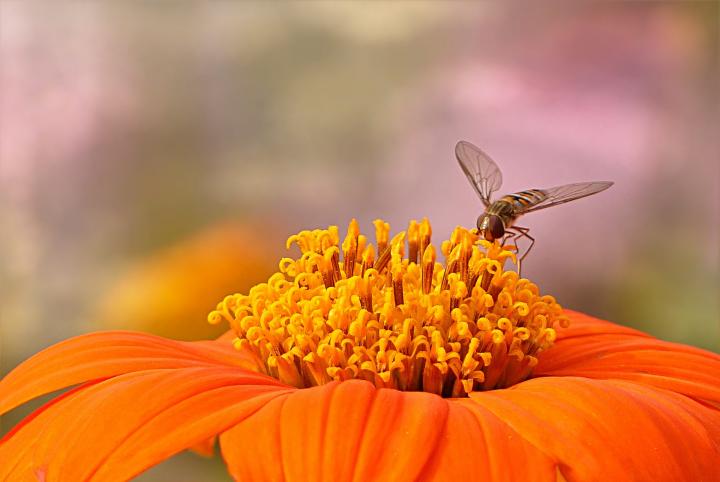
2. WELCOME POLLINATORS AND OTHER BENEFICIAL INSECTS
Pollinators—from bees to butterflies—are vital to our flowers and food. In fact, about one-third of every bite of food we eat stems from the efforts of pollinators!
Native bees are the most important pollinators in most ecosystems. Included in this group are mason bees, miner bees, and leafcutter bees, which are all solitary bees. Instead of living in colonies, like honey bees or bumblebees, solitary bees live on their own in burrows, reeds, or other protected areas. Learn about creating a bee house for native solitary bees.
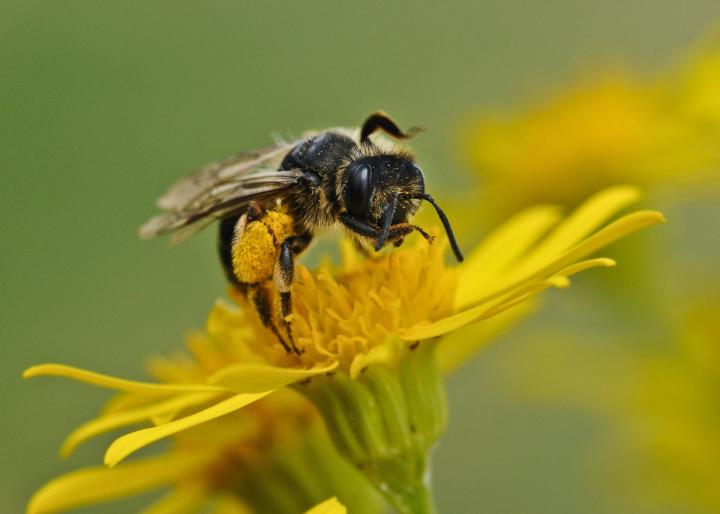
European honey bees, while still valuable, are not native to North America and are much less efficient at pollinating than native bee species. (Native bees may be up to three times more efficient than honey bees!). Read more about native bees, the best pollinators around.
Bees aren’t the only pollinators in the garden, though. Flies, butterflies, beetles, and wasps also play important roles. In fact, while you may expect butterflies to be the #2 pollinator, flies are the ones that hold that title.
Other insects—such as praying mantises, ladybugs, and green lacewings—are fantastic at tackling pests. For example, lacewings and ladybugs eat aphids, which can decimate vegetable crops. Read “Beneficial Insects in the Garden” and see a list of the good bugs with pictures!
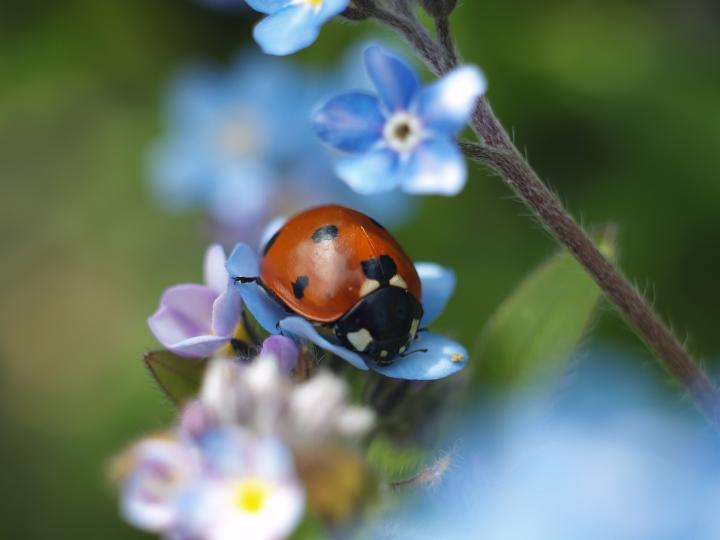
A garden with diversified sources of nectar (e.g., shrubs, trees, and flowers—ideally, natives) that bloom from early spring through late fall can attract insects throughout the growing season and ultimately benefit the entire garden. For example, bright flowers such as sunflowers, candytuft, and marigolds create places where ladybugs and lacewings can shelter and lay eggs.
3. ENCOURAGE BIRDS
A healthy ecosystem invites a wide variety of wildlife to it. Many of your feathered friends will snatch up slugs, snails, grubs, caterpillars, and other pests that destroy garden plants.
- Select native plants that attract the kind of insects, berries, and seeds that birds eat. Learn more about creating a bird-friendly backyard.
- Put up bird feeders and nesting boxes (including those you have made yourself) to encourage more to visit. See how to choose a bird feeder.
- Birds also need water. Install or make a birdbath for them! It should be shallow (1 to 1.5 inches deep) and contain a few small stones or pebbles for birds to rest on.
- Don’t cut down the flowers of plants like sunflowers, coneflowers, and black-eyed susans in the fall, as their seed heads provide a valuable food source for birds in winter.
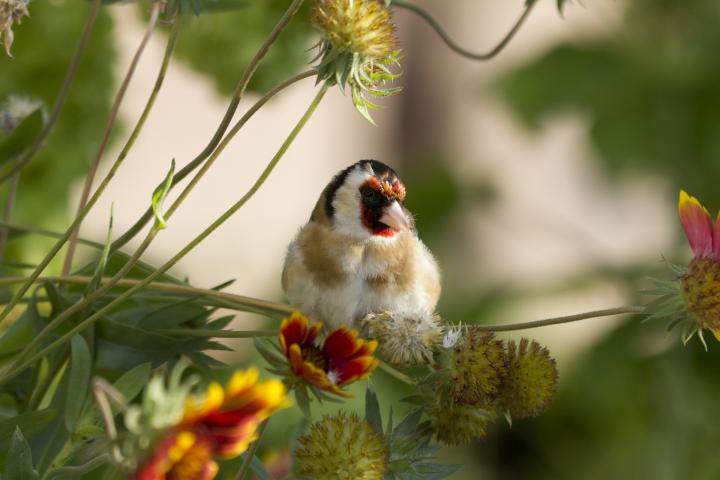
4. BE WATER-WISE
Using water thoughtfully is a very important part of an eco-friendly landscape—and makes both the garden and yard so much easier to manage! Here are tips:
- As advised above, select your plants with care! If you have a dry area, consider plants that are more naturally drought-tolerant such as lavender, sedum, Dianthus (“pinks”), and speedwell (Veronica). If you have a wet area, consider water-tolerant plants (that don’t mind wet feet) such as perennial iris, canna, and elephant’s ear and cinnamon, marsh, and holly ferns.
- In terms of irrigation, sprinklers waste quite a bit of water; at minimum, use sprinklers that have timers. Of course, vegetable and flowers gardens should ideally not be sprayed from overhead; this is an easy way to encourage disease. Use a watering hose and water directly at the soil level. Even better: For gardens, flower beds, trees, and other non-lawn areas, installing a drip irrigation system that puts the water right into the soil, where you want it.
- Harvest your rain water! A rain garden is a shallow, depressed area in your landscape with highly permeable (not hard) soil. This spot collects rain water from a roof, driveway or street and allows it to soak into the ground. Planted with grasses and flowering perennials, rain gardens can be a cost effective and beautiful way to reduce runoff from your property. Rain gardens can also help filter out pollutants in runoff and provide food and shelter for butterflies, song birds and other wildlife. See a “sun” and a “shade” rain garden plot plan.
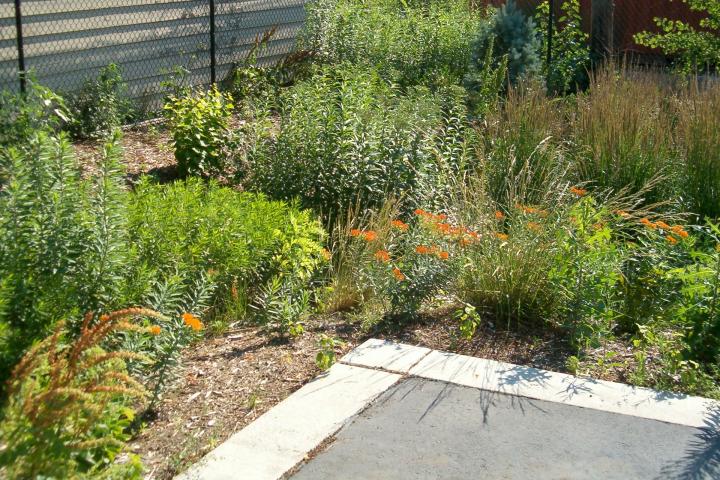
A rain garden, situated at the corner of a parking lot, helps to catch water runoff during rainstorms.
- Alternatively, install a rain barrel to catch water and use it on your plants. See our post about rain barrels.
- Mulch it! Organic mulches such as compost slow water down, so that more moisture goes into the soil instead of running off. Water does not evaporate from the soil surface as quickly, either. Mulch provides nutrients to the soil and helps suppress weeds. Mulch can be applied two inches thick in existing ornamental beds, but don’t pile it too close to tree trunks or the base of plants. Read more about the “Benefits of Mulch.”
- Finally, consider reducing the size of the lawn. Can some of your lawn be converted into a native wildflower meadow? If not, look into planting grasses with low watering needs in order to reduce your water use.
5. MIX IN “COMPANION PLANTS”
Are you familiar with the practice of companion planting? When paired together, certain plants improve each other’s health and yields. Usually, companion plants help ward off pests. For example, dill and basil planted among tomatoes can protect from tomato hornworms.
Also, mix flowers and vegetables together! You don’t have to choose between growing ornamentals and edibles. Many types of flowers confuse the “bad” pests and help you grow a healthier garden.
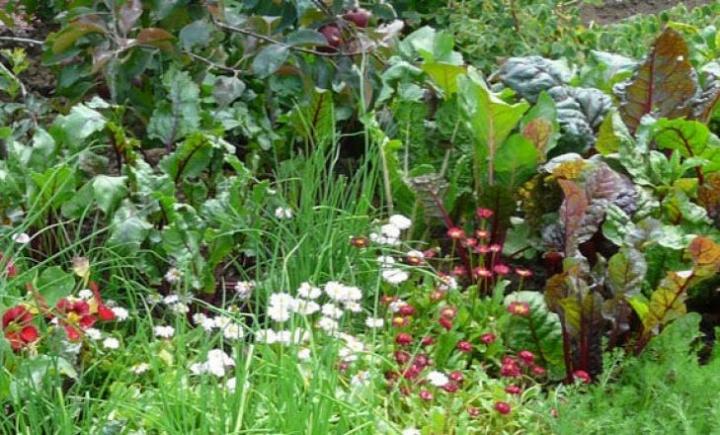
6. AVOID HARMFUL CHEMICALS
All gardens have some pests, but deter them in ways that won’t harm the food you are growing!
For example, slugs and snails can really chow down on lettuce. However, instead of spraying with chemicals, create barriers such as crushed eggshells which these soft-bodies pests tend to avoid. Put a band of petroleum jelly around containers to stop them from climbing up. Another favorite tactic: Sink tuna tins filled with beer into the ground; slugs love beer! See our Slug pest page.
From diatomaceous earth to neem oil, there are many less toxic methods available that really work. Remember that chemical fertilizers run into rivers, oceans and wetlands. Pesticides and herbicides tend to kill many more creatures than the one or two bugs we target, as annoying as they might be.
See how to get rid of garden pests naturally.
7. TRY COMPOSTING
Do you have spare room in the corner of your yard? Instead of throwing out kitchen-based scraps and yard trimmings, dispose of them in a compost pile. You’ll encourage compost-making worms and bugs that help create a rich, fertile soil for your garden within months. It’s a great way to use fallen leaves, too!
- We have the perfect compost recipe to get things cooking. See how to compost!
- There’s also in-garden or in-situ composting, which is when you are composting directly where you’re going to grow. See more about in-garden composting.
- Ever heard of vermicomposting? Just have worms eat your garbage! It’s an easy way to recycle food waste indoors year round. See how to vermipost.
- If you have roses or ornamental gardens, consider “compost tea,” which is a natural fertilizer to help plants thrive. See how to make compost tea.
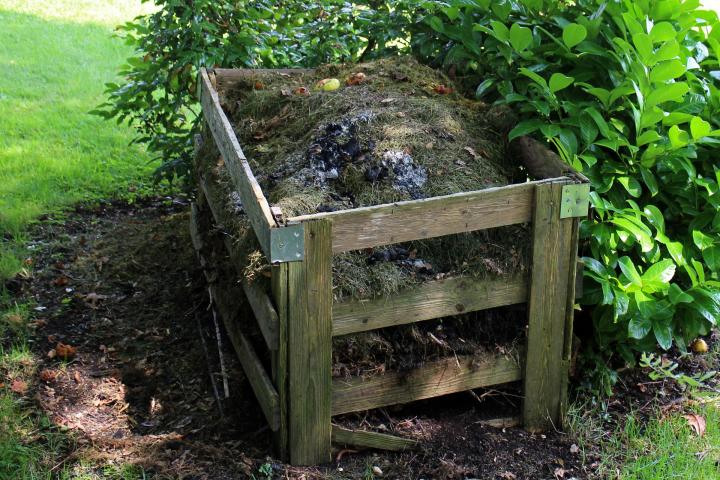
8. REDUCE, REUSE, RECYCLE
In general, caring about yourself and nature means being less wasteful with Earth’s resources. For example:
- Buy in bulk when you know you’ll need a lot of topsoil, mulch, compost, or other materials. This cuts down on plastic bags. Many garden centers will even deliver right to your yard. Also check with your city recycling center or Department of Transportation; they might offer free soil, sand, or other materials.
- Reuse, recycle, or return old plastic pots and trays. See six ways to reuse pots and containers.
- In fact, you could even make your own plant pots! See how to make biodegradable plant pots.
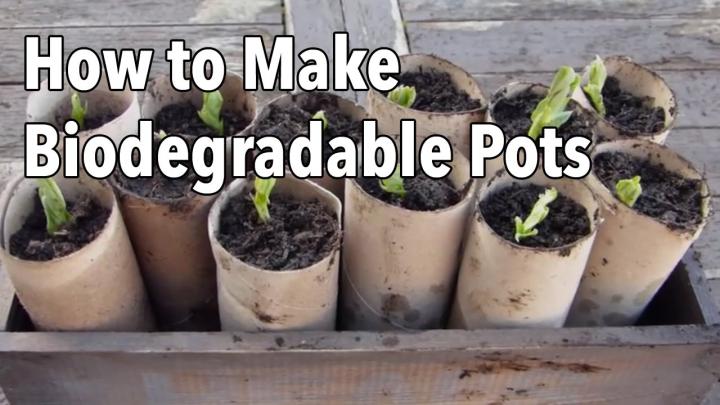
9. GIVE GRASS A CHANCE TO THRIVE ALONE
If you’re going to grow grass, eliminate the chemical pesticides you spread on lawns in favor of alternatives that are healthier—healthier for you, for the lawn, and for the environment.
- Start by checking the soil pH (acidity) of your lawn with a test kit available at most nursery and garden supply stores, or at your state’s cooperative extension service. Soil pH affects the ability of plants to absorb nutrients. Spread limestone to raise the pH level; spread aluminum sulfate to decrease the pH level.
- Grow grass that is suitable to your needs, not just in terms of climate and soil, but also purpose. Ask your nursery to recommend seed for grass that suits your site.
- Don’t shave the lawn down to the ground; mow it to be 2.5 to 3.5 inches tall all season. Cut it to about 2 inches in autumn.
- And, if at all possible, use a hand mower, instead of an electric or gas model. You’ll appreciate the freedom from fumes and noise and perhaps sleep more soundly after walking your property.
10. BUY GOOD GARDEN TOOLS
We’re frugal at The Old Farmer’s Almanac, but let’s not be penny-wise and pound-foolish. For example, forget about the $1 garden hose. It’s probably going to break quickly and just become another item to throw out. Vinyl hoses are generally the least expensive, but have the shortest lifespan. Rubber hoses are more expensive, but tougher, more flexible, and last longer. Also, get a brass coupling—not plastic—to cut down on leaks!
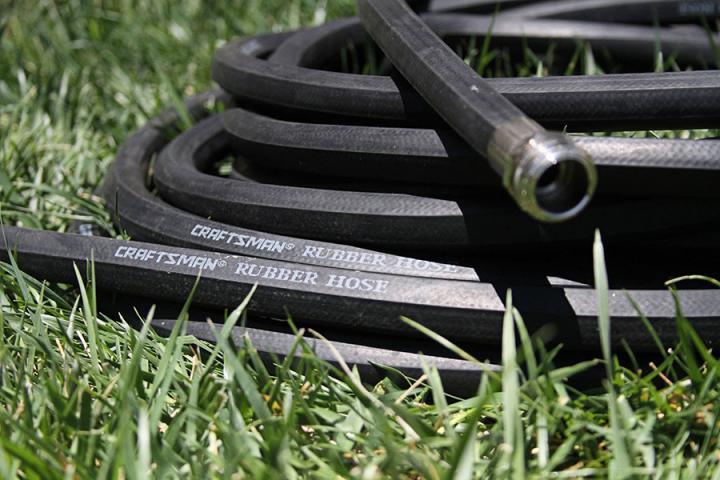
Go for quality over quantity. Do you really need to purchase every tool for every landscape use? If you use a tiller once a year, consider borrowing a neighbor’s tiller. If you have your own set of tools, lend the weed-eater out twice a year.
Also, if you have time, stop at garage sales and thrift stores. It’s amazing how many garden tools are just sitting in someone’s garage and usually the older tools are better crafted than the new ones! If you have your own tools just sitting around and unused, donate them to a neighbor or thrift shop!
WORK WITH NATURE, NOT AGAINST IT
We hope these eco-friendly ideas help you create a garden and yard that works better with nature; it’s a win-win for all of us.
Is your garden eco-friendly? Leave your suggestions in the comments below!
This article was first published on the Farmer’s Almanac website, March 27, 2019:
:https://www.almanac.com/content/plant-pollinator-garden-10-ways-work-nature

Best view i have seen for long time !